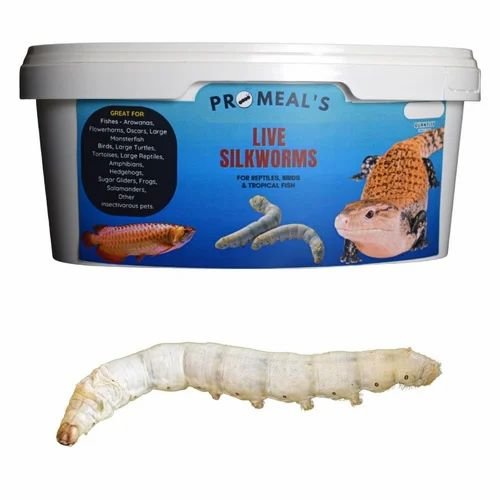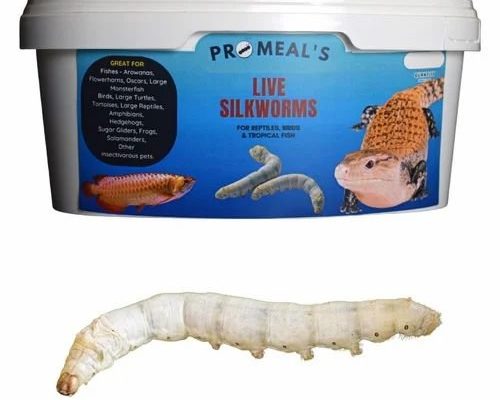
Silkworms are not just a trendy new food; they’re a complete meal that can significantly benefit your reptiles and fish. They’re soft-bodied, making them easy to consume for many species, and they provide essential nutrients that can enhance your pets’ health. So, if you’re interested in elevating your feeding game and exploring new options for your scaly or finned friends, let’s dive deeper into why silkworms could be the perfect addition to their diet.
Why Choose Silkworms for Your Pets?
You might be wondering, “What’s so special about silkworms?” Well, here’s the thing: they offer an impressive nutritional profile that can benefit a wide range of reptiles and fish. Silkworms are high in protein, boasting around 60% protein content. This makes them an excellent food source for growing or breeding reptiles and fish that need to build muscle.
In addition, silkworms contain healthy fats, vitamins, and minerals that support overall health. They’re low in calories and packed with fiber, making them a great choice for maintaining a healthy weight in your pets. Compared to other feeder insects like crickets or mealworms, silkworms can provide a more balanced diet. If you’re aiming for a well-rounded menu, silkworms definitely deserve a spot on the plate.
But what does this mean for your pet? In reptiles, a rich protein source encourages growth and proper development, while fish benefit from fats and vitamins that support vibrant colors and overall vitality. Feeding your pets a variety of foods can help prevent nutritional deficiencies. So why not make silkworms a regular part of their diet?
Nutritional Benefits of Silkworms
Silkworms are tiny powerhouses when it comes to nutrition. Here’s a quick breakdown of what they offer:
- High Protein Content: Silkworms are rich in protein, which is vital for growth and energy.
- Essential Fatty Acids: They contain omega-3 and omega-6 fatty acids, supporting heart and brain health.
- Rich in Vitamins: Silkworms provide vitamins like B12 and E, which are essential for overall health.
- Minerals: They are a good source of calcium and phosphorus, important for strong bones.
This impressive nutritional profile makes silkworms an ideal food for young reptiles and growing fish. Their unique combination of nutrients can help strengthen your pets’ immune systems, improve their skin and scales, and even support healthy growth rates. It’s like giving them a multi-vitamin in snack form!
Feeding Silkworms to Reptiles
When it comes to feeding silkworms to reptiles, the process is straightforward. First, ensure you’re sourcing silkworms from a reputable supplier. Fresh, high-quality silkworms are key to providing your lizards or snakes with the best nutrition.
The next step is to determine the right portion size. Most reptiles are going to need a variety of foods in their diet, and silkworms can usually be fed 2-3 times a week. You can offer them live silkworms or dried ones, depending on your pet’s preference. For species like bearded dragons, silkworms can be an exciting treat. They often enjoy the variety and will show more interest in a diet that includes different textures and flavors.
Finally, always make sure that your reptiles have access to fresh water. Hydration is vital, and while silkworms do contain moisture, it’s essential not to rely solely on this source for hydration.
Feeding Silkworms to Fish
You might think silkworms are just for reptiles, but they can also be a fantastic food option for certain fish species. Many aquarium fish thrive on a varied diet, and silkworms can be a great addition.
To feed silkworms to fish, you can either use live silkworms or freeze-dried ones. Live silkworms can be particularly enticing to carnivorous fish, as they dart around in the water, triggering their hunting instincts. If you choose freeze-dried silkworms, just be sure to soak them in water for a few minutes before feeding. This will make them easier for your fish to digest and more appealing.
When introducing silkworms to your aquarium, start with small amounts to gauge how your fish react. Some species might go nuts for them, while others may take a little time to warm up to this new food. The key is patience. You’ll likely find that silkworms can add a dynamic element to your fish’s diet, improving their health and wellbeing.
Comparing Silkworms to Other Feeder Insects
While silkworms are excellent, how do they compare to other popular feeder insects like crickets or mealworms? Each type of insect has its own nutritional strengths, so it’s essential to consider your pets’ specific needs.
Crickets are widely used due to their high protein content and availability, but they can sometimes have a higher fat content compared to silkworms. Mealworms, on the other hand, are often less nutritious due to their lower protein and higher fat ratios. They can also be harder for young reptiles and certain fish to digest because of their tougher exoskeleton.
In contrast, silkworms provide a much softer option that’s easier for pets to eat, especially for young, growing animals. Plus, they offer essential nutrients without the higher fat levels associated with some other insects. So, while crickets and mealworms have their place in the feeding regimen, silkworms often provide a well-rounded alternative that can benefit your animal’s health.
How to Store and Care for Silkworms
If you’re considering incorporating silkworms into your pet’s diet, you’ll want to know how to store and care for them properly. One common option is to keep them as live food, which is often the best way to ensure they stay fresh and nutritious.
Live silkworms should be stored in a cool, ventilated area, away from direct sunlight. A simple container with some ventilation holes will do. They thrive on a diet of mulberry leaves or special silkworm chow, which ensures they stay healthy until it’s feeding time. If you live in a cooler climate, you might need to provide heat to keep them thriving, as they prefer warm conditions.
For those who prefer the convenience of freeze-dried silkworms, they should be kept in a cool, dry place. Just make sure to keep the bag tightly sealed to maintain freshness. Regardless of which option you choose, it’s crucial to monitor your silkworms regularly. Healthy silkworms will lead to healthy, happy reptiles and fish.
Final Thoughts on Silkworms
Incorporating silkworms into your reptile or fish feeding routine could be a game-changer. They’re not just another type of food; they bring a wealth of nutrients that can enhance your pets’ health, growth, and vitality. Whether you have a curious lizard or a vibrant aquarium, silkworms can add much-needed variety and excitement to their diets.
Remember, sourcing high-quality silkworms and combining them with other feed options keeps your pets happy and healthy. With their natural appeal and excellent nutrition, silkworms might just become a favorite feast for your scaly and finned friends. So why not give them a try? Your pets might thank you for it!

